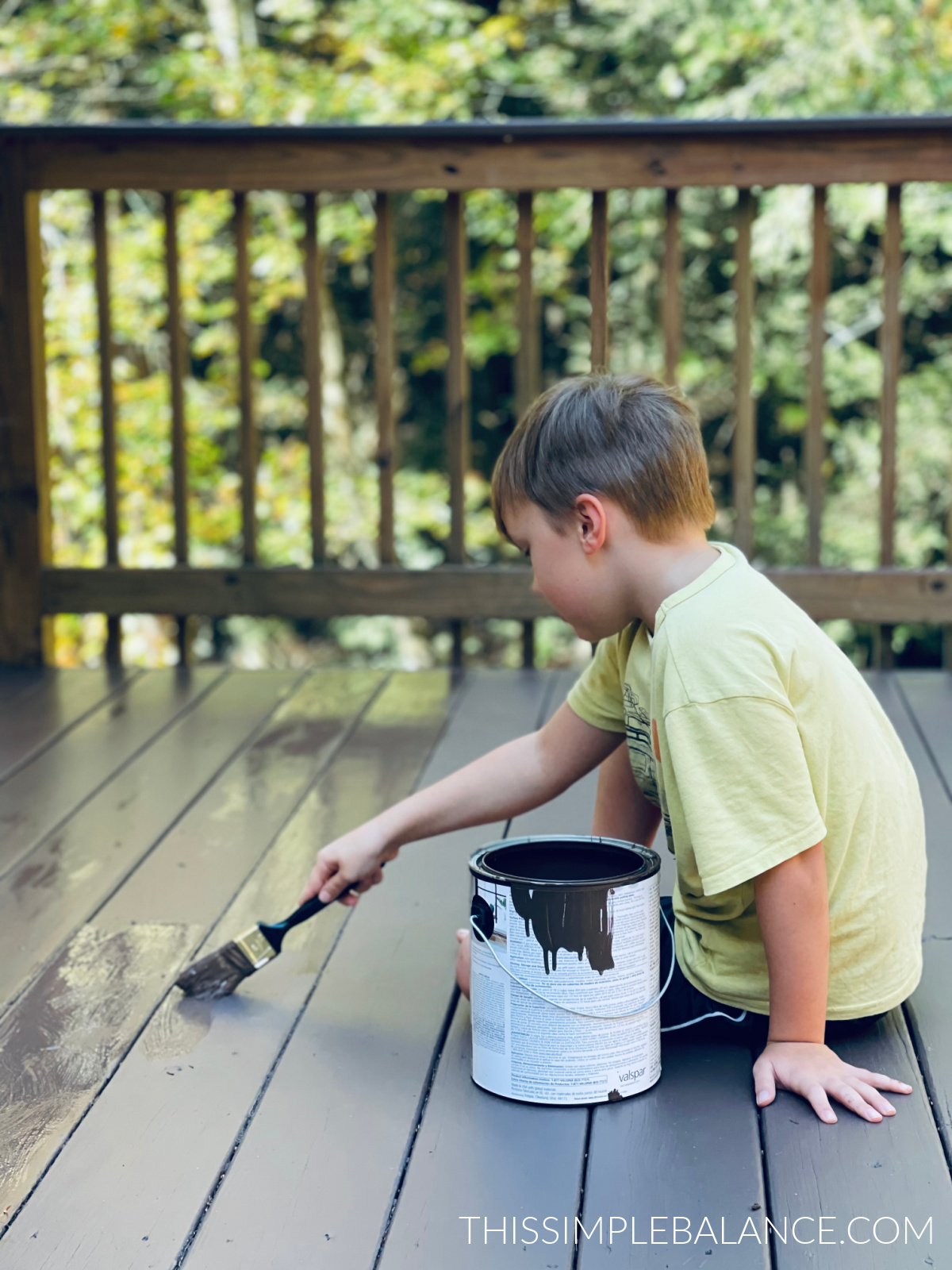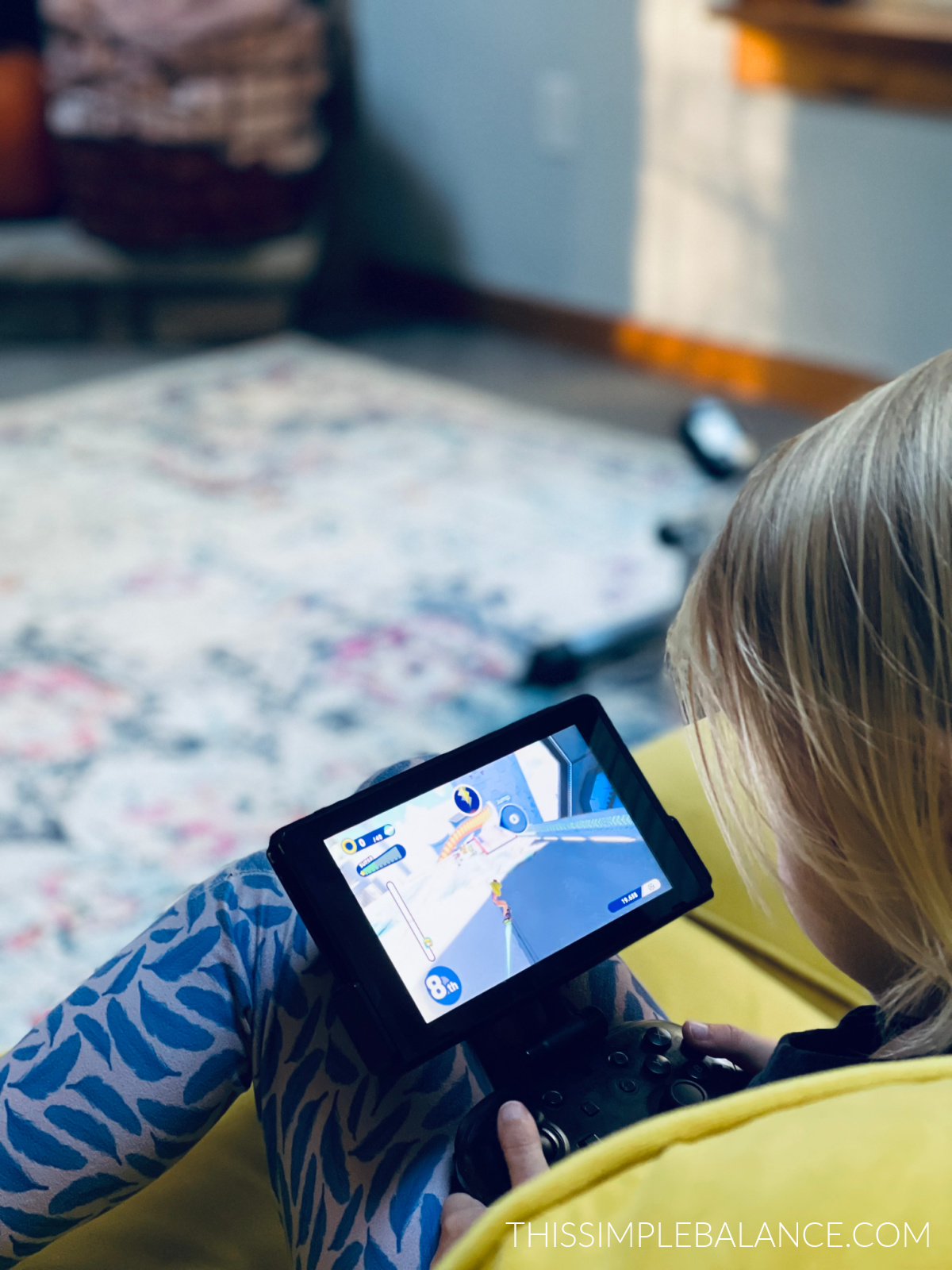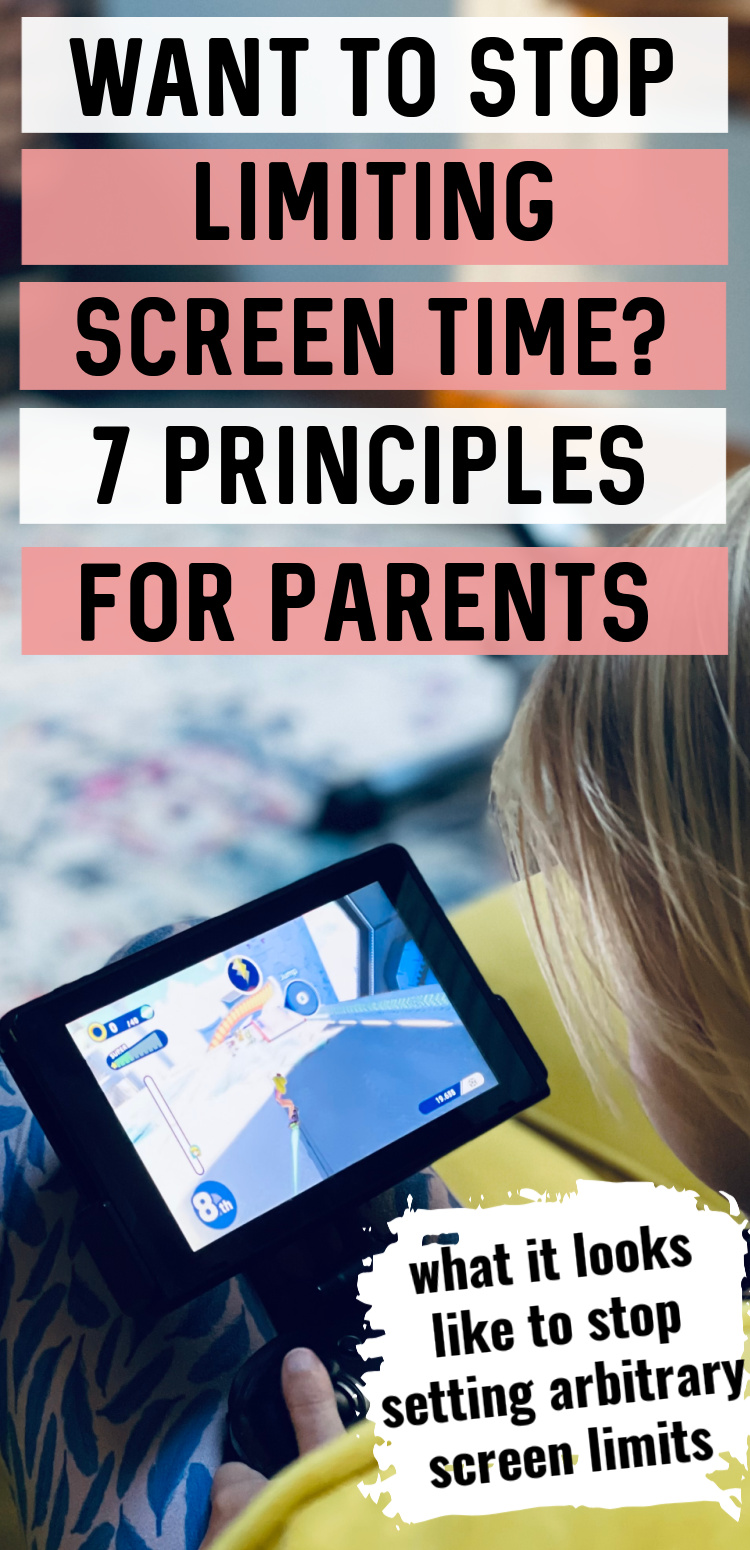Inside: If you’re a parent considering not limiting screens, but you’re not really sure what that looks like, here are seven guiding principles that make it work for our family of seven.
The deep dive started with a Minecraft video that just happened to have a volcano.
“Daddy, are there volcanoes in real life?” my 4-year-old asked.
“Yes, there are. Do you want me to find some videos for you?”
“Yes, please!”
First he found a Youtube short showing a volcanic eruption, but it wasn’t enough to satisfy her curiosity. She begged for more.
So the next video was 25 minutes long, covering several different volcanoes around the world.
She watched the entire thing. Still, she begged for more!
Finally, after an hour, she was done, ready to move one. But when I came home, she wanted to show me the video and proceeded to watch it with me again.
Then I told her about the statues of Pompeii, created by a volcanic eruption, and we watched a short video on that, too.
More questions bubbled to the surface like, “Does lava really turn to rock when it hits water?”
And we found answers to that, too.
Where did we find answers to her questions? On a screen.

It’s Been 3 Years Since We Chose to Stop Setting Arbitrary Screen Time Limits
This post probably contains affiliate links, which means I may earn a commission if you make a purchase through those links. As an Amazon Associate, I earn from qualifying purchases. You can find our full disclosure HERE.
We’ve had countless moments like this one since letting go of screen time limits. I honestly don’t know how we would successfully unschool without this approach to screens.
They learn so SO much from screens, and that learning comes from what some parents would consider “non-educational” content.
My youngest has grown up with unlimited screen time, and I would say she is the most balanced in her screen use of all my five kids. She would honestly prefer to be playing with friends somewhere outside the house.
Has it been rocky to navigate exactly what this looks like for our family? Yes. But it was 100% worth it.
Almost three years have passed since I wrote the original post about unlimited screen time.
Since that time, there have been many comments from families trying to figure this out.
After reading enough comments, I realized I need to define unlimited screen time more clearly and give some practical guidance for parents wanting to try this approach.
You Might Also Like: Food Autonomy for Kids – The “Guardrails” That Make It Work

7 Guiding Principles for Parents Who Want to Stop Limiting Screen Time
I’m going to unpack how our family navigates this choice practically speaking, and I’ll offer some clarity around the role of the parent in unlimited screen time.
You’re still the parent, and this choice doesn’t mean unparenting.
It does mean that you stop leading with top-down, my way or the highway, authoritarian (and even authoritative) parenting methods, and transition to a collaborative, democratic and respectful parenting approach.
Right away, let’s clear one thing up:
When I say unlimited screen time, I mean not setting arbitrary “parent decided” limits on screens during children’s free time, such as “2 hours only” or “screens are allowed only after 4 p.m.” or “screens only on weekends”.
For us, free time looks like any time that we’ve determined is not dedicated to family, friends and/or necessary activities, such as…
- Family dinners,
- Bedtime routines,
- Homework times.
Again, this is only my approach. I know others who establish far fewer boundaries, and others who set far more. I can only share what has worked for us.
Let’s unpack what I believe is the role of the parent in unlimited screen time.
You Might Also Like: What Is Respectful Parenting? A Sadly Radical Philosophy
1. You can establish pre-bedtime cut-offs and collaborative screen-free periods.
If your kids come home from school at 4pm, they’ve done their homework, and they have three hours of free time until their bedtime routine starts, screens would be an option during that time if you’re not limiting screens.
But if you have children in school who need to wake up at a certain time, so they need to start their bedtime routine at a specific time, that means screens need to go off to start that routine.
We homeschool, so the kids that rely on me for bedtime have cut-offs that revolve around that bedtime routine. We need about an hour to complete that routine, so I ask them to wrap up whatever they’re doing an hour before bed.
They value the bedtime routine, so we usually don’t have a problem with a natural cut-off.
When we hit about age 11, where we start handing over the reins for experimenting with their own bedtime routines, including screentime cut-offs.
As a parent, I’ve decided that screens don’t come on most car rides, unless we’re going on a family trip or a trip longer than 45 minutes. They know they have mostly unlimited screen time at home, so they don’t argue with this boundary (plus, there’s no internet in the car, anyway).
We only have dinner as a family about once a week, but we have, as a family, collaboratively decided that during those dinners, there are no screens.
You are still the leader and the parent. Collaboratively discuss and work out your own family boundaries and talk about why you have them.
When your kids know they have access to screens during their free time, they feel trusted, and they have a voice and vote in deciding about screen-free periods, they most likely won’t have problems with suggested boundaries.
If they do, discuss with them your reasons and ask them for suggestions on what they would like to do differently and the potential outcomes of those decisions.
2. Kids determine how much, but parents decide what apps and devices are available.
With things like food and technology, there are natural limits based on what you, the parent, decide to bring into your home.
We offer a lot of food freedom in our house, but we don’t live in a grocery store or with a limitless food budget.
The available food choices are limited to what and how much I choose to bring into the house, and some of that is based on our budget (another natural limit!).
The same goes for technology.
There are apps I say “no” to, usually really crappy games with a lot of ads that I know will be glitchy and frustrating to play. Others, I choose to pay for because they offer a lot of value.
For Youtube, there are channels we subscribe to for our younger children, and they stick to the approved list.
Parents can decide how many devices and TVs, what apps, and whether or not to have a home computer. They can decide to not sign their children up for social media or give them phones.
I’m always open to my children’s requests and ideas, and I give good reasons when I say no to a purchase or subscription.
They usually aren’t upset because they know I say yes a lot more than I say no and because we…
3. Talk about the dangers and challenges of screens in our world today frequently.
We talk A LOT about the dangers of screens in our home.
We talk about how when you only know someone online, they can be anyone they want to be.
We discuss the unlimited amount of content in the world today, like how there are 3.7 million new Youtube videos uploaded daily. That number blows my mind!
We talk about the possible effects of screens on your body. Things like…
- Staying in the same position or not moving your body enough,
- Eye-sight concerns,
- Brain confusion about day v. night and delay or lower melatonin production,
- Potential effects of social media on mental health.
When you discuss these things regularly from a young age, it gives them information they need to make decisions about screen time as they grow.
4. Use gentle nudges and open-ended suggestions when you’re uncomfortable with the amount…but be open to “no thanks”.
If I’ve noticed a lot of screen time use over a particular period, I will suggest other activities with varying directness, depending on the child I’m “nudging”.
One in particular has an innate stubborness. He’s a rebel through and through – and that’s just who he is.
With that child it’s very important that I offer and suggest with the freedom to say, “No”.
OR I offer choices like, “Getting outside time and exercise is really important to keep your body healthy and strong, so would you like to go to the park today or tomorrow?”
Other children I can be more direct with. To my 11-year-old gamer, I might say, “You’ve been on the computer a lot today. Your eyes could probably use a break.”
The ability to nudge comes from a strong relationship based on trust, not control.
If they say a hard “no”, they know that most of the time I’ll accept it, unless it’s impossible to work around (e.g. doctor’s appointments). Then it’s a “come and have fun or come and don’t have fun” type of situation.
You could also do activities like games or puzzles by yourself in front of them, without inviting at all. They just might join you!
5. Offer a rich life outside of screens, including fun screen-free activities in the home.
Screens are truly incredible. I mean, isn’t it amazing that in video games you can actually BE the adventurer in a story, instead of just pretending outside with sticks and stones? All for a pretty low cost.
If you want them to stay off of screens more, you need to offer compelling reasons to leave them.
Board games, read-alouds, trips to Costco and the library and the park, nature walks, zoos and aquariums, museums are just a few ideas we use.
Granted, all of these things cost money: the whole subject of to limit or not to limit screen time at is chock full of complicated privilege, just like the 1000 hours outside movement.
Youtube and TV shows offer a glimpse into things you might not be able to afford to do, like travel or expensive hobbies and sports. And I value them for that.
In the meantime, try to offer alternatives – and make sure they see you choosing those yourself!
Related: Our Movement-Centered Minimalist Playroom (for Long, Cold Winters)
6. Observe and ask your children – without judgment – what they are getting from their screen usage.
Talk to your children about why they love what they love on their apps/games/shows of choice.
Why do they love that video or show? Watch it with them. See why they love it. You might be surprised to find that you’re enjoying it, too.
Do you have complete and utter disdain for video games, while your kids adore them?
There are so many benefits to video games! Try playing them yourself every once in a while to understand why your kids enjoy them.
You need to start unpacking your underlying beliefs about video games and try to understand because they will absolutely sense your disdain for something they love.
That’s true for just about anything.
Looking down on screens (instead of acknowledging your personal preference to not use them as much) will make them less likely to talk to you about their screen choices when it matters most.
7. Your kids are watching how you use screens all the time: monitor and discuss your own screen use.
Nothing drives me crazier than a parent talking about limiting kids’ screen time when they, the parent, are glued to their screen all day.
I spend a good deal of time using my computer for work and my smartphone for all kinds of things, for all kinds of reasons. Honestly, that was part of what motivated me to stop restricting my own children’s screen time.
I try my best to let them know exactly what I am doing on the screen:
- Reading a book or blog
- Listening to music
- Social media
- Writing a blog post or email
- Watching a show
- Scheduling the week on the calendar
- Paying bills
- Messaging a friend
- Working.
I also inform them about my own screen choices and boundaries.
For instance, I recently decided to drastically cut back on my Tiktok usage. It was negatively affecting my mental health, increasing my anxiety, and I told my kids as much.
Staying open about your own use of screens and your own decision-making around screens will help your kids form their own unique and healthy boundaries now and in the future.

Does Not Limiting Screens Only Work When You Unschool? Maybe?
I am very aware that unlimited screen time might only be possible within the context of unschooling
Unschooled children have so much more free time available to them and a lot more autonomy compared to their traditionally schooled peers. When free time isn’t scarce, perhaps children choose a wider variety of activities besides screens?
I also know that for school families, their lives often revolve around school. With that revolving usually comes caring an awful lot about academic performance.
For our family, we aren’t worried about academic performance in our home: it’s not even in our orbit really. I don’t assign grades.
I know my kids are learning all day every day, and my biggest concern is that they are happy and healthy. I know whether or not they are happy and healthy because I stay connected to them every day.
So when I read studies that claim too much screen time correlates with “worse” or “lower” academic performance, I can’t relate, and honestly, I shake my head (and I hear “correlation does not equal causation” echo in my head).
Performance reminds me of race horses and other animals, being weighed and measured and assessed. I sometimes wonder how we don’t all shudder collectively as a society at these terms when they are applied to children.
I firmly believe that at least part of the mental health crisis in teens comes from the pressure of academic performance, and I have no qualms about eliminating that pressure during childhood.
And as I’ve already stated, my kids learn so much from screens. They are constantly sparking new interests like cooking or science or Boolean algebra.
We also don’t use punishments and rewards to change the behavior of our children. We stay connected, we trust, and we use age-appropriate aids for challenging behaviors.
Screens are never a bargaining chip to get the behavior we desire. We don’t hold them out as a carrot for good performance.
Choosing to not limit screens will only work in an atmosphere of trust and connection. Without that? Unlimited screen time will most certainly go awry in one way or another.
Related: The Pros and Cons of Unschooling – Some Brutal Honesty

Read the Arguments About Screens on Both Sides, Listen to Your Gut and Make the Best Decision You Can for Your Unique Family
We are parenting during extremely challenging times.
Stepping off the beaten path beyond “this institution recommends only 1-2 hours a day of screens for children of such and such age” is challenging because all of this is SO new.
We have a mini computer in our pockets with 24/7 internet access and more information about the lives of people we don’t know than ever before. Even as adults, we struggle all.the.time.
We are a generation of parents figuring out this very new, very modern problem. It’s going to take a lot of trial and error – not prescriptive rules and regulations made out of fear.
Did you know that parents used to be afraid of children being addicted to reading? Yes, reading. Just like they are afraid of too many screens today.
I’ve read the research. I’ve heard the arguments. I disagree with some, but not all of them.
Maybe you will disagree, too. Or maybe you won’t.
Whatever you decide, stay strong! Weigh the options and make the best choices you can for your unique family and your unique children.
Be open to challenge and change, but ultimately trust your child and your gut.
I am confident it will lead you exactly where you need to be with screens – whether that’s limiting or not limiting them – and with every other challenging parenting decision ahead.
Read Next: The Best Respectful Parenting Books I Wish I’d Read Sooner


